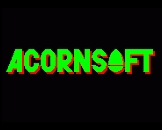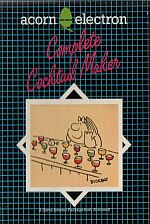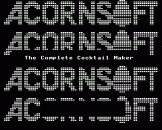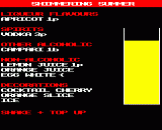Blurb
If you are a party person (and can stand the competition) be sure to include Complete Cocktail Maker in your guest list. The program contains data sufficient to concoct over 300 different drinks to suit every mood and taste.
Browse through its large bank of colourful recipes or give your friends the fun of devising their own cocktails from drinks you happen to have. Alternatively, use the program to confide in your computer - name some favourite ingredients; divulge your personal tastes; share even a part-remembered phrase or word to summon up some piquant taste long lost in the mists of time.
It's a must for every party season.
The computer program is based upon an original idea and original material contained in a book entitled The Complete Cocktail Maker by Geoffrey Hindley, published by Ebury Press, copyright (C) Geoffrey Hindley 1983."
Introduction
The Complete Cocktail Maker contains details of over 300 interesting and colourful cocktails which will suit every mood and taste. You can browse through them at your leisure and find out how to mix your favourite drinks on your own home. Alternatively you can try finding out which drinks you can make with the contents of your cocktail cabinet, simply enter all your ingredients and in a few moments you'll be presented with the whole possible range.
Using The Program
The program starts by displaying the Main Menu:

Choose one of the options by entering the number next to it and pressing RETURN. The Main Menu can be returned to at any stage by pressing ESCAPE.
Option 1. Browse
Option 1 allows you to browse through all the cocktails which the program knows about. The cocktails will be displayed in alphabetical order and to move through them you should use the right and left arrow keys. These keys take you to the next cocktail and the previous cocktail respectively. Using the | (SHIFT and left arrow) and ^ (SHIFT and right arrow) keys will move you on ten recipes in either direction (or to the last or first ones if less than ten recipes in remain at that end). The keys \ (CTRL and right arrow) and ~ (CTRL and left arrow) move to the last and first cocktails respectively.
Option 2. A Drink Containing...
This option allows you to search for all the cocktails which contain one or more particular ingredient, eg you may wish to search for all the cocktails which contain vodka and orange juice. Four menus will be presented displaying liqueur flavours, spirits, other alcoholic and non-alcoholic ingredients. The liqueur flavours menu is shown first and you can move to the others using the right and left arrow keys.
To select a particular ingredient move to the page containing it, place the cursor to the left of the ingredient using the down and up arrow keys and then press COPY. This will have two effects; firstly it will tell the computer that you are only interested in drinks containing that particular ingredient and secondly it will change the colour of the ingredient and secondly it will change the colour of the ingredient on the screen as a reminder for you that it has been selected.
If you change your mind about including a particular ingredient you can cancel your selection by carrying out the same procedure as described above for selecting it but pressing the DELETE key instead of the COPY key. This will revert the ingredient back to its original colour.
When you have selected all the ingredients you want in your cocktail then press RETURN. A 'Searching' message will appear and the computer will look through to find all the cocktails which it knows about that meet your criteria. Remember that the more restrictive you are about what the cocktail should contain, the longer this search will take and the fewer cocktails will be found. A search for a drink which contains one or two specified ingredients will take about 15 seconds.
After the search is complete, the program will display the first cocktail that it has found. You can then move through all of them as described in option 1. If no cocktails have been found then a message will be shown and by pressing the Space Bar you will be presented with the whole file to browse through.
You may wish to make your rules less stringent if a search has failed to find any cocktails or maybe just one or two. Alternatively, if you searched for all the ones containing just one common ingredient, eg orange juice, it could find too many for you to look through. In either of these cases you could press ESCAPE to return to the Main Menu, select option 2 again and re-enter your new selection. However, an easier method of returning to your menus with the ingredients you previously selected still indicated. This allows you to check which ingredients you chose and to alter, add to or reduce your selection.
Note: After pressing ESCAPE you will not be able to return to your original selection.
Option 3. A Drink Made Using...
This option allows you to find all the cocktails you can make using the range of ingredients you have available in your drinks cabinet. Ingredients should be selected in a similar manner to option 2 above. In this case, however, you may find it useful to use [ (SHIFT-COPY) or SHIFT-DELETE to include or cancel all the drinks shown on the current screen.
It is assumed that you will always have some of the possible non-alcoholic ingredients, eg water, sugar etc and so these are not listed but are automatically selected for you.
To start the search again, press RETURN. The 'Searching' message will be displayed and a few seconds later, the first recipe found will be shown. You may move through the recipes as described in option 1. If no cocktails are found then a message will be shown and by pressing the Space Bar you will be presented with the whole file to browse through. You may return to the menu pages by pressing "D" to see which ingredients you included. This allows you to see the effect of adding a couple of bottles to your cabinet without having to re-enter all the ones which were originally marked as being included.
Note: After pressing ESCAPE, you will not be able to return to your original selection.
Option 4. Describe The Drink...
In this option you are asked to enter the name or part of the name of the cocktail you want information about, then if the program knows about the cocktail it will display the recipe for it. For example, entering PINA COLADA will present you with the recipe for this cocktail. However, if only PIN was entered, several recipes will be presented in turn: PEPINO, PEPPIN THE INSPIRED, PINA COLADA, PINEAPPLE SIMPLE and PINK DAIQUIRI.
How The Cocktails Are Displayed
The information about a typical cocktail is shown below.

The ingredients are listed under four different headings; liqueur flavours, spirits, other alcholic and non-alcoholic. In addition, there is a fifth category which lists the decorations which are suggested for making the cocktail more attractive when serving it. In most cases, the ingredients will be followed by a number and letter, eg 1p, 2d or 3b. This indicates the amount to be used; p is an abbreviation for part, d for dash and b for barspoon.
The actual volume of a 'part' depends on the number of drinks required. To start with, the easiest way to make up small numbers is to use a medicinal measuring beaker with millilitre graduations. A standard 4oz cocktail glass holds just over 112ml (1 fluid oz = 28.4ml). If you are making two drinks of a recipe requiring, let us say five main parts, then simple arithmetic shows that you need about 225ml in total or, divided by 5, 45ml of each part.
A barspoon has the same capacity as a teaspoon. The dash is an intermediate small measure but a rough guide gives four dashes to the barspoon. Where the dash or barspoon features in a recipe that quantity is needed for each of the drinks to be mixed.
If no amount is indicated then the ingredients should be added to taste. Although the amounts are those recommended by the author, they should not neccessarily be stuck to rigidly. Try experimentin by altering proportions to find out what effect this has.
When ingredients such as rum or sherry are included then use the type of your preference. Liqueurs are classified by their flavour and when, for example, a recipe calls for an orange flavoured one then any in this category may be used. The flavour categories which the individual liqueurs are classified under are as follows:
| Almond | Amaretto |
| Blackcurrant | Creme de Cassis |
| Apple | Apple Brandy, Calvados |
| Cherry | Cherry Brandy, Maraschino |
| Apricot | Apricot Brandy |
| Drambuie | Drambuie |
| Orange | Cointreau, Curacao, Grand Marnier, Mandarine Napoleon |
| Herbal | Benedictine, Green Chartreuse, Yellow Chartreuse, Galliano |
| Banana | Creme de Banane |
| Mint | Creme de Menthe |
| Cacao/Coffee | Chocolate Liqueur, Coffee Liqueur, Creme de Cacao, Kahlua, Tia Maria |
| Aniseed | Anisette, Pernod |
The final piece of text concerns the mixing method. Nearly all cocktails are mixed on ice either in a shaker or a mixing jug, and ideally the glasses should be chilled as well. When mixing cocktails the following rules generally apply:
- Pour non-alcoholic ingredients first (unless fizzy), followed by the still alcoholic ingredients and finally any fizzy ingredients.
- Shake when the recipe includes fruit juices, eggs, cream etc with a sharp, vigorous action but not for too long. Top up shaken drinks with any fizzy ingredients or non-alcoholic ones which are to be added to taste.
- Stir when all the ingredients are clear, as shaking would tend to cloud them, as does too-energetic stirring.
Do not expect the final cocktail to be the same colour as the one shown. Cocktails come in over a million different shades. Ours are as realistic as is possible working with only eight different colours. In some cases it will depend on which ingredients you have used, eg 'Flying Boat' is illustrated as being made using Blue Curacao, however if you only have one orange flavoured liqueur which happens to be Cointreau then the drink will be an orange colour.
The following lists the type of glass to be used according to capacity:
Cocktail glass. Capacity 3-4 ounces.
Highball glass; tall, straight-sided tumbler of 8-12 ounces cap.
Wine glass. Capacity 4-8 ounces.
Old-fashioned glass or whisley tumbler of 8 ounce capacity.
Campagne glass. Capacity 5 ounces.







